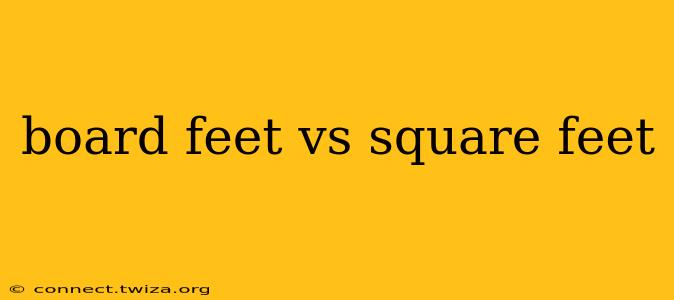Understanding the difference between board feet and square feet is crucial, especially when working with lumber. While both measure area, they do so in vastly different ways, leading to confusion if not properly understood. This article will clarify the distinction, helping you confidently navigate lumber calculations and avoid costly mistakes.
What is a Square Foot?
A square foot (sq ft) is a unit of area measurement. It represents the area of a square with sides measuring one foot each. It's a straightforward calculation: length (in feet) multiplied by width (in feet). This measurement is commonly used for flooring, drywall, and other flat materials. Think of it as the surface area.
What is a Board Foot?
A board foot (bd ft) is a unit of volume measurement specifically designed for lumber. It represents a piece of wood measuring 1 foot long, 1 foot wide, and 1 inch thick. It's important to note that the thickness is in inches, while the length and width are in feet. This is the key difference that sets it apart from square footage.
Calculating board feet involves a slightly more complex formula:
(Thickness in inches) x (Width in feet) x (Length in feet) / 12
The division by 12 converts the inches to feet to arrive at the final board foot measurement.
Why Use Board Feet Instead of Square Feet for Lumber?
Square feet alone don't account for the thickness of the lumber. A 2x4 that is 8 feet long will have a much larger volume (and therefore, a larger amount of wood) than a thin sheet of plywood with the same surface area. Board feet account for this volumetric difference, making it a more accurate representation of the amount of wood you're purchasing. This is particularly important when pricing lumber, as the cost is usually based on the volume of wood, not just the surface area.
How to Convert Square Feet to Board Feet?
You cannot directly convert square feet to board feet without knowing the thickness of the lumber. Square feet only measure the surface area, while board feet measure volume. To convert, you need the thickness of the wood in inches.
Let's say you have a piece of lumber with a surface area of 10 square feet (that's length x width). If the thickness is 1 inch, the board foot measurement is also 10. If the thickness is 2 inches, the board foot measurement will be 20.
What are the Different Ways to Calculate Board Feet?
There are several ways to calculate board feet, depending on the lumber's dimensions and whether you're dealing with individual pieces or a batch.
- Individual Boards: Use the formula mentioned above: (Thickness in inches) x (Width in feet) x (Length in feet) / 12.
- Multiple Boards of the Same Dimensions: Calculate the board feet for one board and then multiply by the number of boards.
- Boards with Irregular Shapes: These require more complex calculations, often involving breaking the shape down into smaller, more manageable sections.
How Do I Calculate Board Feet for Different Lumber Sizes?
The calculation remains the same regardless of the lumber size. Always ensure your measurements are consistent (inches for thickness, feet for width and length). For example: a 2x4 that is 8 feet long would be calculated as follows: (2 inches) x (4 inches/12 inches per foot) x (8 feet) / 12 = 0.53 board feet. Note that 4 inches is converted to feet (4/12).
Why is understanding board feet important for contractors and builders?
Accurate board foot calculations are critical for contractors and builders to determine material costs and quantities. Overestimating or underestimating can lead to significant financial implications and project delays. Understanding this critical difference ensures accurate budgeting and efficient material ordering.
In conclusion, while both square feet and board feet represent area, board feet accounts for the lumber's volume, making it essential for accurate lumber measurements and cost calculations. Understanding the difference between these two units is crucial for anyone working with wood.
